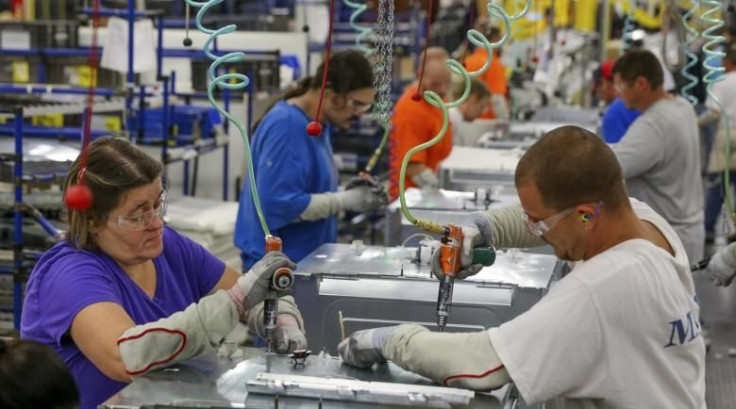US Economy 2017: Does Factory, Confidence Data Brighten Outlook Ahead Of Incoming Trump Administration?

New orders for U.S. manufactured capital goods rebounded in October, driven by rising demand for machinery and a range of other equipment, the latest indication of an acceleration in economic growth early in the fourth quarter.
The brightening economic outlook received a further boost from other data on Wednesday showing a jump in consumer sentiment this month in the wake of the election of Donald Trump as the next president. Consumers viewed the business mogul's victory as positive for their personal finances and the economy's prospects.
While the number of people filing for unemployment benefits rose from a 43-year low last week, the trend in claims remained consistent with a tightening labor market. Overall, the tone of the reports was supportive of views that the Federal Reserve will raise interest rates next month.
"One thing we can give thanks for this Thanksgiving Day weekend is the economy. It is in good shape and is starting to accelerate," said Joel Naroff, chief economist at Naroff Economic Advisors in Holland, Pennsylvania.
The Commerce Department said non-defense capital goods orders excluding aircraft, a closely watched proxy for business spending plans, rose 0.4 percent after declining 1.4 percent in September. These so-called core capital goods orders have now increased in four of the last five months.
Shipments of core capital goods rose 0.2 percent last monthafter a 0.4 percent gain in September. Core capital goods shipments are used to calculate equipment spending in the government's gross domestic product measurement.
"Although it is still early in the quarter, this increase in core capital goods shipments raises the prospect for the first increase in business equipment spending within GDP in five quarters," said John Ryding, chief economist at RDQ Economics in New York.
In a separate report, the University of Michigan said its consumer sentiment index rose 8.2 points from the pre-election reading to 93.8. That left the index 6.6 points above the October reading. UMich said the post-election boost in optimism was widespread, with gains recorded among all income and age subgroups and across all regions of the country.
Separately, the Labor Department said initial claims for state unemployment benefits increased 18,000 to a seasonally adjusted 251,000 for the week ended Nov. 19.
Claims have now been below 300,000, a threshold associated with a healthy labor market, for 90 straight weeks. That is the longest run since 1970, when the labor market was much smaller.
The four-week moving average of claims, considered a better measure of labor market trends as it irons out week-to-week volatility, fell 2,000 to 251,000 last week.
BULLISH ECONOMIC SIGNALS
The reports joined bullish data on housing starts, home and retail sales, as well as firming inflation in painting an upbeat picture of the economy at the start of the fourth quarter.
The Atlanta Federal Reserve is forecasting GDP rising at a 3.6 percent annual rate in the fourth quarter. The economy grew at a 2.9 percent pace in the July-September period. The steady stream on upbeat reports suggest Trump will inherit a strong economy from the Obama administration.
Against the backdrop of a brightening economic outlook, a labor market that is near full employment and rising inflation, the Fed is expected to hike interest rates at its Dec. 13-14 policy meeting. The U.S. central bank raised its benchmark overnight interest rate last December for the first time in nearly a decade.
The dollar extended gains versus the yen, rising to its highest level since April on the data. Prices for U.S. government debt fell.
Business spending on equipment has bucked the acceleration in economic growth as the residual effects of a strong dollar and lower oil prices continue to curb profits of some companies.
Business spending on equipment has declined for four straight quarters, weighing heavily on manufacturing, which accounts for 12 percent of the U.S. economy.
With the dollar's rally appearing to have peaked early this year and oil and gas drilling activity rising in recent months, there is cautious optimism that equipment spending will rebound in the fourth quarter.
Capital investment is also expected to pick up as some of the uncertainty surrounding the Nov. 8 presidential election clears. Trump has pledged a massive infrastructure spending program, which could spur business investment on capital equipment.
That would boost companies like heavy machinery maker Caterpillar, which last month lowered its full-year revenue outlook for the second time this year.
A 12 percent surge in demand for transportation equipment buoyed overall orders for durable goods, items ranging from toasters to aircraft that are meant to last three years or more,which jumped 4.8 percent last month.
That was the biggest rise since October 2015 and followed a 0.4 percent increase in September.
There were also increases in orders for fabricated metal products, electrical equipment, appliances and components, and computers and electronic products.
(Reporting By Lucia Mutikani; Editing by Andrea Ricci)
© Copyright IBTimes 2024. All rights reserved.



















